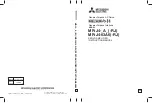
CONTENTS
REMOTE PROGRAMMING
Remote programming allows the technician to access the system database from a
remote location for the purpose of making changes to the customer data. Customer-
provided modems and a PC using an optional software package will be needed to
implement this feature. A PC can also be connected directly to a MISC card for on-site
programming.
RING OVER PAGE
Any outside line can be programmed to ring over a customer-provided paging system.
Outside lines, door phones and station groups may ring over page in the DAY or NIGHT
mode.
SINGLE LINE CONNECTIONS
Single line ports allow for connection of a variety of single line telephones plus fac-
simile machines, answering machines, loud bells, computer modems, cordless phones
and credit card machines. When connecting customer-provided equipment to these
extensions, compatibility should be checked out before purchase to ensure correct
operation.
SPEED DIAL NUMBERS (1500)
A library of up to 1500 speed dial numbers may be allocated as needed. RAM Pack 1
provides 500 speed dial numbers. RAM Pack 2 and Caller ID/CTI software provide
1500 speed dial numbers. The system list can have up to 500 numbers and each
station can have up to 50 numbers. Speed dial numbers are assigned in blocks of ten.
Each speed number may contain up to 18 digits.
STATION HUNT GROUPS (30)
System programming allows for up to 30 station hunt groups. One of three ring pat-
terns are available for each group: SEQUENTIAL, DISTRIBUTED and UNCONDI-
TIONAL. Each group may contain a maximum of 30 stations and a station may be in
more than one group. The default directory numbers to call these groups are 501–529.
Group 500 is reserved for the operator group and is called by dialing “0.” Each station
group has its own recall timer for calls transferred to that group.
STATION HUNT GROUPS (UCD)
The UCD group option allows callers in queue at a UCD group to be temporarily diverted to
a customer-provided announcement device and then placed back in the queue. A wrap-up
timer allows agents to complete paperwork before receiving the next UCD call.
STATION MESSAGE DETAIL RECORDING (SMDR)
The system provides, via an optional MISC card, records of calls made, received and
transferred. Connecting a customer-provided printer or call accounting system will al-
low for collection of these records. Each call record provides details of station number,
4.1.15
















































